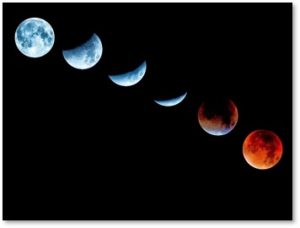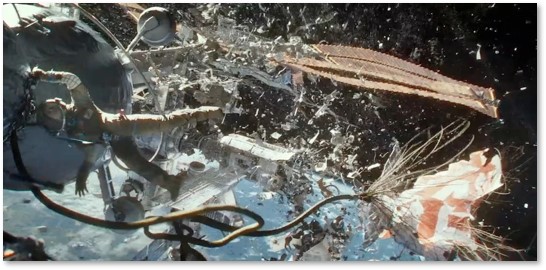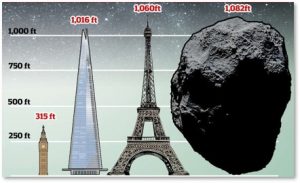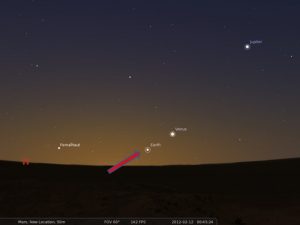The sky is putting on a show this week while, at the same time, a Gravity-style danger emerged to everyone’s surprise in low Earth orbit. That means it’s time for a Sky News blog post–an update on what’s going on up there.
The Leonid Meteor Shower
 The Leonid Meteor Shower peaked on Tuesday and Wednesday. If you missed it, don’t feel bad. Two reasons: (1) the moon, only two days from full, will flood the western night sky with light. (2) The Leonids lacked any significant activity this year—only about 10 to 20 meteors per hour. In other words, the meteor shower will be lackluster and dimmed out.
The Leonid Meteor Shower peaked on Tuesday and Wednesday. If you missed it, don’t feel bad. Two reasons: (1) the moon, only two days from full, will flood the western night sky with light. (2) The Leonids lacked any significant activity this year—only about 10 to 20 meteors per hour. In other words, the meteor shower will be lackluster and dimmed out.
The meteors we do see come from Comet Tempel-Tuttle, a regular visitor that sweeps through the inner solar system every 33 years or so. When the comet passes close to the sun it leaves a trail of debris in its wake. We see a meteor storm when Planet Earth goes through a fresh dust trail ejected by the comet.
The Leonid meteors fan out from the constellation of Leo, the lion. Because they orbit the sun in a direction opposite to that of Earth, they slam into our atmosphere nearly head-on. This produces the fastest meteor velocities possible: 45 miles (72 kilometers) per second. These high speeds typically produce bright meteors, which leave long-lasting streaks or vapor trains in their wake.
Given that the meteor shower would be a bust, plus a cold night, we stayed inside.
The Long Lunar Eclipse
That bright full moon will dim for quite a long time on Friday morning. That’s when the Beaver Moon passes into Earth’s shadow, creating a partial lunar eclipse. It will be so deep that NASA says “it can reasonably be called almost total.”
 The entire eclipse will last just over six hours from when the moon enters the shadow until it exits. The visible part of the eclipse will last almost three and a half hours. That makes it the longest partial lunar eclipse in 580 years.
The entire eclipse will last just over six hours from when the moon enters the shadow until it exits. The visible part of the eclipse will last almost three and a half hours. That makes it the longest partial lunar eclipse in 580 years.
What you will see (if you can see it) will be the Beaver Moon Lunar Eclipse—a blood moon because of the reddish color caused by sunlight bending through earth’s atmosphere before it reaches the moon.
Here in New England, the weather forecast predicts cloudy skies, so the Beaver Moon Lunar Eclipse will go on without us.
Danger in Orbit
Astronauts in the International Space Station (ISS) had to shelter in the transport capsule that carried them there because a cloud of space debris was headed in their direction.
Turns out that Russia had blasted a de-commissioned Kosmos satellite into trackable pieces—more than 1,500 of them—along with thousands of smaller fragments. The astronauts (four Americans, two Germans and one Russian) had to hunker down for several hours while the ISS passed through the debris cloud.
This news immediately recalled a similar scene in the movie Gravity. In the film, the space debris destroys the ISS, shattering it into a million pieces and killing most of the astronauts in the process. The most vivid image, for me, was a wrench that whips through an astronaut’s helmet, leaving a wrench-shaped hole in the man’s head. (I found a picture but it’s too gruesome to include here.)
Why would Russia do such a dangerous thing? They were testing a missile and used the old Kosmos satellite as a target. The Russians defended their lame-brained decision by saying that the missile test had been a success. I’ll bet that really made the Russian astronaut crouched in his transport capsule feel much better.
While U.S. officials criticized the Russians, who have defended their actions, the ISS passes through or near the field of test debris every 90 minutes.
The Eiffel Tower Approaches
Meanwhile, an egg-shaped asteroid about the size of the Eiffel Tower is on its way for a pre-Christmas visit. The asteroid, called 4660 Nereus, or 1982 DB, is expected to pass by Earth on or about December 11. Although classified as a Potentially Hazardous Asteroid, Nereus will hurtle past us at a distance of 2.4 million miles. That makes it close enough for us to observe it without worrying about contact.
The moon is 238,855 miles from the Earth.
Traveling at 6.578km/second, Nereus is moving almost 11 times faster than an F-16 fighter jet’s top speed. Between its size and its speed, any impact with Earth would be devastating.
We can all be grateful this Thanksgiving that Nereus will give us a holiday fly-by.
All the Sky News for November
That’s the Sky News for this week in November. When I’m out at night, though, I find myself looking up and visualizing our beautiful planet hanging out there in cold, dark, and empty space.
That’s the image we see from our instruments on Mars and it’s a frightening one. The only things protecting us from outer space is our atmosphere, our magnetosphere, and our proximity to the Sun.
On winter nights in New England, it’s easy to imagine that cold darkness swooping down on us. Then I go inside, grateful for my warm, bright house.



